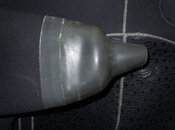- Messages
- 7,659
- Reaction score
- 4,720
- # of dives
- 200 - 499
Channeling is a big issue with me, -tendons when working on something or collecting mussels. Best for me is a bottle seal (see pic) that is flat and right below the wrist and above the tendons. I most definitely need some sort of lubricant for this type of seal....//... I was actually thinking that if wrist seals were tucked, so they went up the arm instead of down, they would be less on top of the part of my wrist where the tendons might stand out, so they would be less likely to get a channel. ...
Neck is the exact opposite. Best for me is neoprene (foam) with two inches folded in. Flat does not work for me, it channels.




